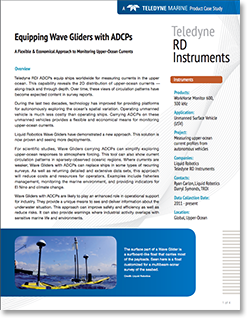Monitoring Currents with ADCPs on Wave Gliders
Leigh Martin — April 6, 2017
Some of the best applications of technology are ones where someone takes a longstanding process and reimagines it.
At one point, people thought “why would I need a camera in my phone?” Now it’s hard to imagine our smartphones without them. It’s simply a more efficient way to get the data—in this case a picture—and instantly send it where it needs to go, off to Facebook or Instagram.
In the world of ocean research, an example of this is taking the longstanding process of using acoustic Doppler current profilers (ADCPs) on boats, and asking the ADCPs to conduct their work on unmanned vehicles instead. The cost savings can be significant: a single day of research vessel operation costs can cover an entire month’s work by an unmanned vessel.
In Marine Technology Reporter, Dr. Peter Spain of Teledyne RD Instruments discusses how ADCPs on Wave Gliders offer a viable, flexible way to get critical upper-ocean current data.
Like in the smartphone camera example, ADCPs on Wave Gliders simply provide a more efficient way to get the data and instantly send it where it needs to go.
There are other advantages as well. The communications links on the Wave Glider offers the flexibility to make real-time adjustments to the sensor based on results or operational needs, reconfiguring a profile, or turning bottom tracking on or off.
The whitepaper includes several mission examples where ADCPs were used on Wave Gliders and include turbidity surveys, assisting seismic streamer operations, and improving maritime domain awareness.
Teledyne also has a case study available on this topic. If you have a project that requires ADCPs in water depths greater than 10M, consider the cost savings and flexibility of ADCP on unmanned systems like the Wave Gliders. Contact us to learn more about ADCP on Wave Gliders.

